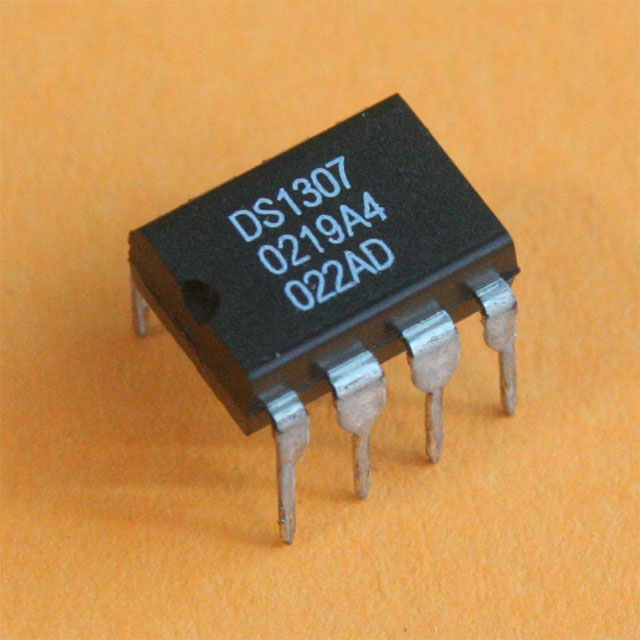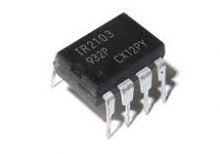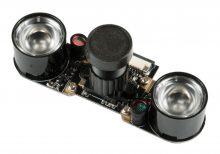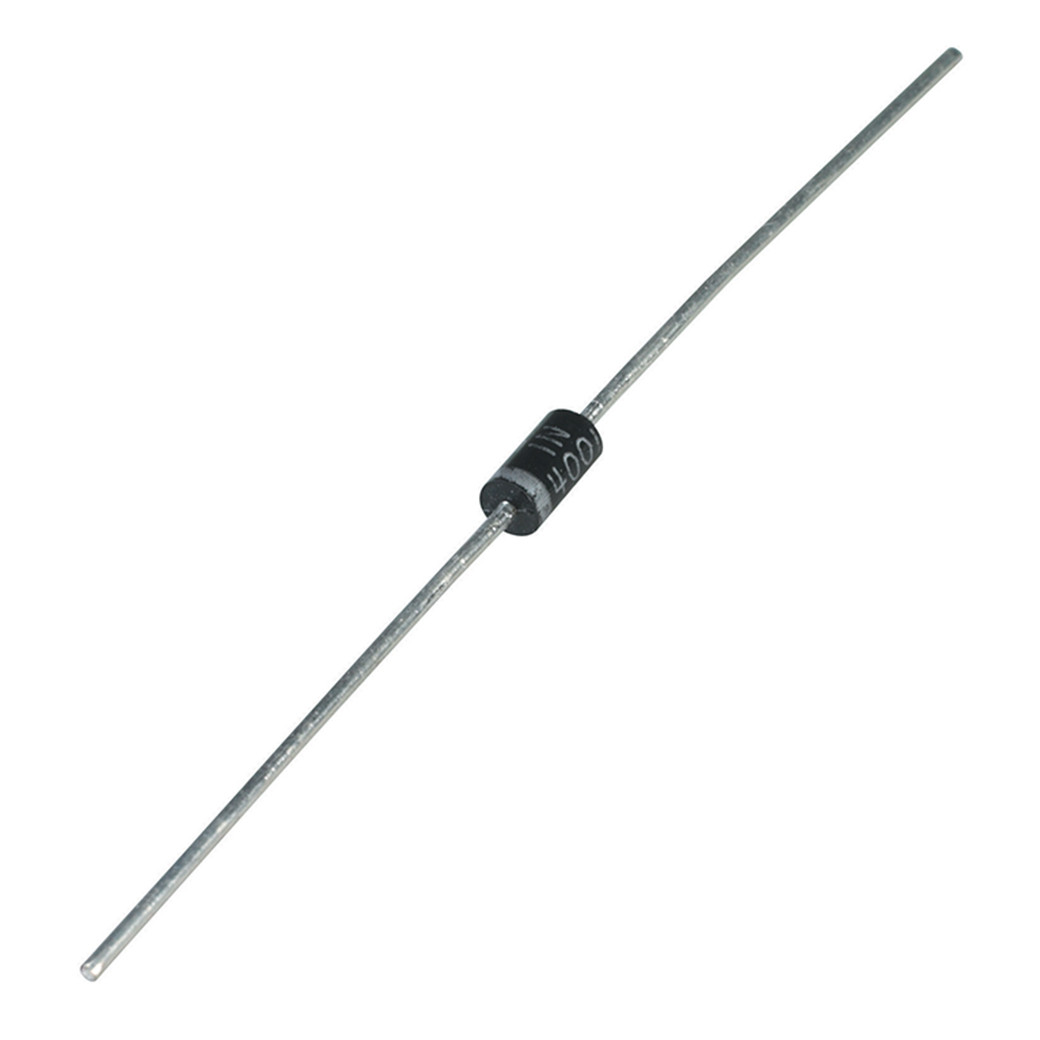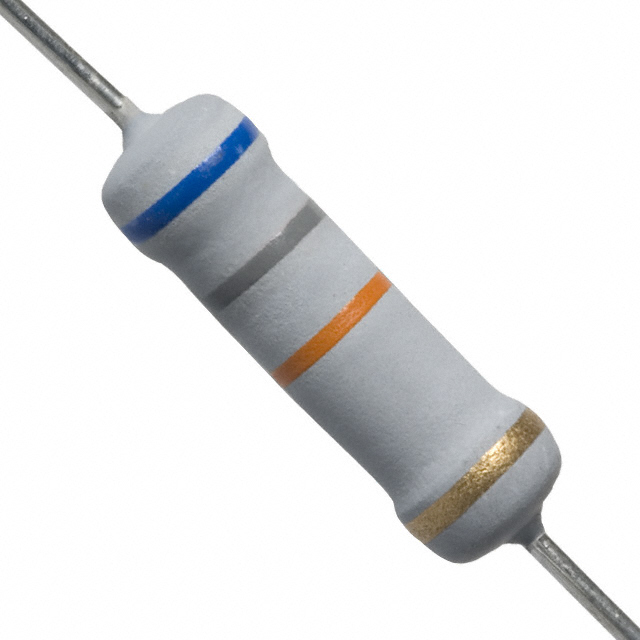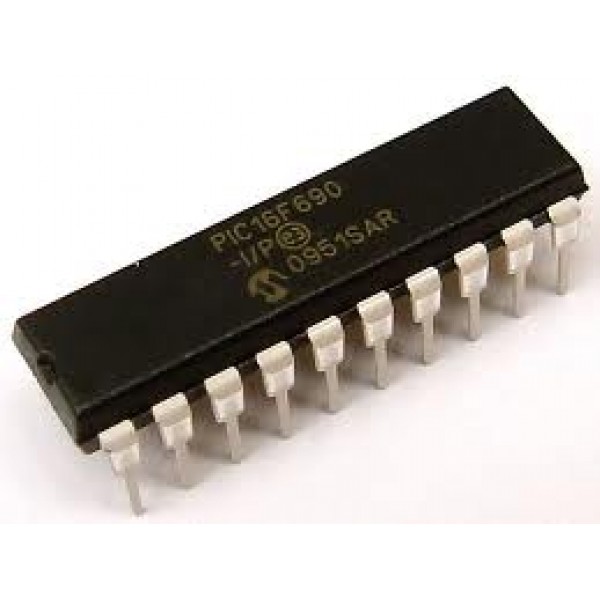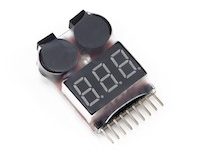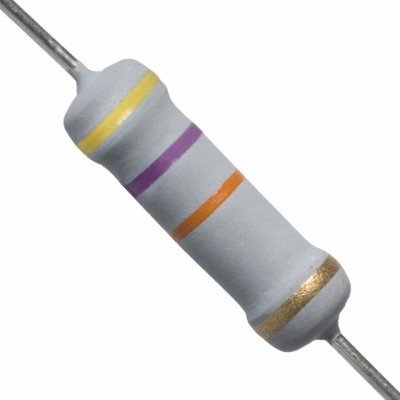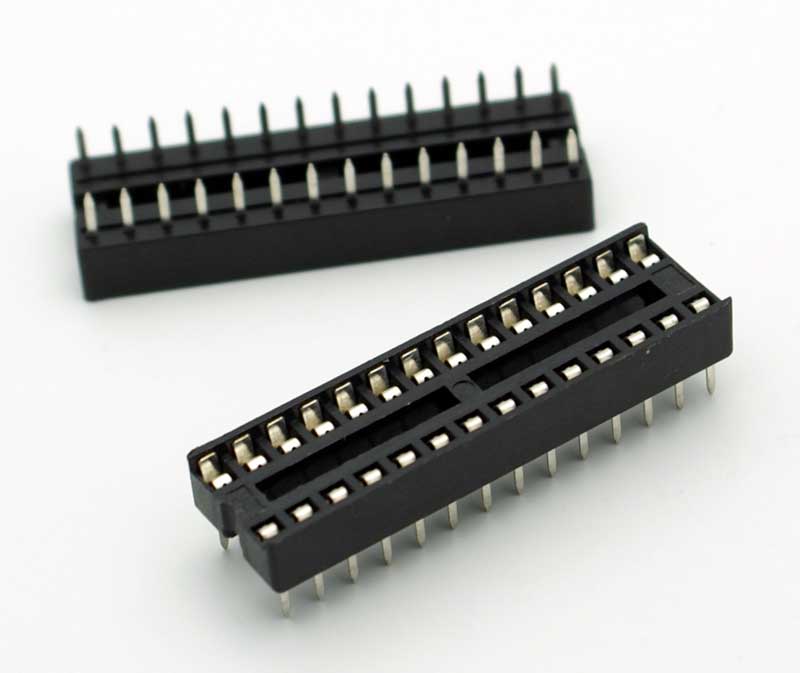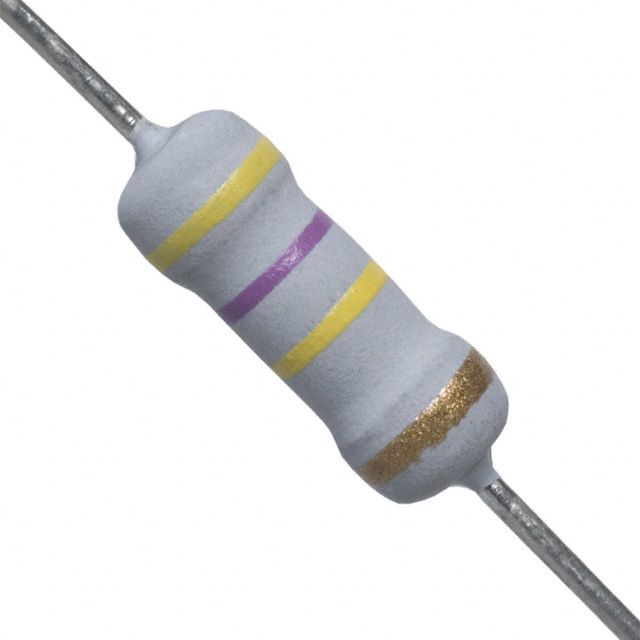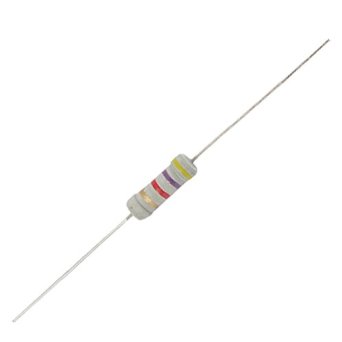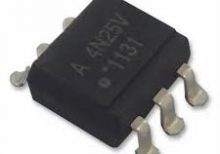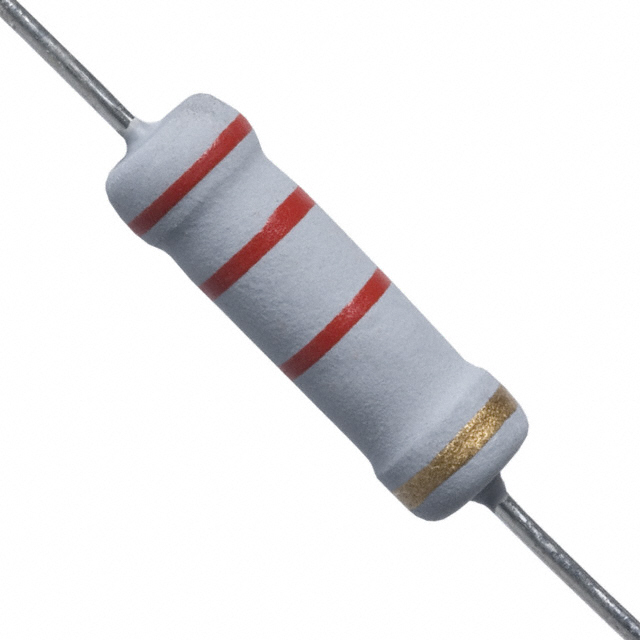|
Description |
The PIC16F72 is an 8-bit microcontroller from Microchip’s PIC family, featuring a 14-bit instruction set architecture and a range of peripherals designed for embedded applications. It includes a 13-bit program counter, a variety of I/O ports, timers, and an integrated analog-to-digital converter (ADC), making it suitable for applications requiring basic processing and control functions.
Key Features:
- 14-bit instruction set architecture
- 4KB Flash program memory
- 192 bytes SRAM data memory
- 128 bytes Electrically Erasable Programmable Read-Only Memory (EEPROM)
- 16-bit Timer0 and 8-bit Timer1
- 10-bit Analog-to-Digital Converter (ADC)
- 13 I/O pins with interrupt-on-change capability
- Enhanced PWM module
- Watchdog Timer (WDT) and Power-on Reset (POR)
- Low-power sleep mode
Technical Specifications:
- Operating Voltage: 2.0V to 5.5V
- Operating Frequency: Up to 20MHz
- Program Memory Size: 4KB (Flash)
- Data Memory Size: 192 bytes SRAM
- EEPROM Size: 128 bytes
- Number of I/O Pins: 13
- Analog-to-Digital Converter (ADC): 10-bit, up to 8 channels
- Timers: 16-bit Timer0, 8-bit Timer1
- Package Type: 18-pin DIP, SOIC, SSOP
Applications:
- Embedded systems
- Home automation
- Industrial control
- Consumer electronics
- Automotive applications
- Data acquisition systems
Usage:
- Connect the microcontroller to a power supply within the operating voltage range.
- Program the microcontroller using the Flash program memory for storing application code.
- Utilize the I/O pins for interfacing with external devices and sensors.
- Configure the ADC and timers for data acquisition and timing functions as needed.
- Implement necessary peripheral configurations in the software.
Caution:
- Ensure proper voltage levels are maintained to prevent damage.
- Avoid exceeding the maximum current ratings for I/O pins.
- Handle the device carefully to prevent static discharge damage.
Datasheet:
For detailed technical specifications, refer to the PIC16F72 Datasheet.
|
The 2N3904 is an NPN bipolar junction transistor (BJT) designed for general-purpose low-power switching and amplification. Renowned for its high current gain and low noise, the 2N3904 is versatile and widely used in various electronic circuits, including signal processing, switching, and low-power amplification.
Key Features:
- Type: NPN Bipolar Junction Transistor (BJT)
- High Gain: Provides high current gain (hFE) for effective signal amplification
- Low Noise: Suitable for low-noise applications
- Compact Package: Available in a TO-92 package, ideal for space-constrained designs
Technical Specifications:
- Collector-Emitter Voltage (Vce): 40V
- Collector-Base Voltage (Vcb): 60V
- Emitter-Base Voltage (Veb): 6V
- Collector Current (Ic): 200mA
- Power Dissipation (Ptot): 625mW
- DC Current Gain (hFE): 30 to 300
- Transition Frequency (ft): 300MHz
- Package Type: TO-92
Applications:
- Signal Amplification: Ideal for use in low-power amplification circuits
- Switching: Suitable for general-purpose switching applications
- Audio Circuits: Effective in audio signal processing and low-power amplification
- General Purpose: Versatile for various electronic applications and projects
Usage:
- Circuit Design: Integrate the 2N3904 transistor into your circuit based on your specific application requirements.
- Biasing: Properly bias the transistor to ensure optimal performance for amplification or switching.
- Connection: Connect the collector, base, and emitter terminals as per your circuit design.
- Testing: Verify the transistor’s operation in your circuit to ensure it functions correctly.
Caution:
- Voltage and Current Ratings: Adhere to the maximum voltage and current ratings to prevent damage.
- Heat Management: Ensure adequate heat dissipation to avoid overheating, especially in high-current applications.
- Static Electricity: Handle with care to avoid damage from electrostatic discharge (ESD).
Datasheet:
For detailed technical specifications, refer to the 2N3904 Transistor Datasheet.
|
The DS1307 is a real-time clock (RTC) IC from Maxim Integrated, designed for accurate timekeeping in electronic systems. It provides reliable and precise time and date information and features a battery backup to maintain time during power outages. The DS1307 is commonly used in applications such as clocks, data loggers, and time-based control systems.
Key Features:
- Accurate real-time clock (RTC) with date and time functions
- Battery backup to maintain time during power loss
- Communicates via I²C interface
- High-precision timekeeping with a 32.768 kHz crystal oscillator
- Provides time and date information (seconds, minutes, hours, day, date, month, year)
- Low power consumption with battery operation
- Simple interface with microcontrollers and digital systems
Technical Specifications:
- IC Type: Real-Time Clock (RTC)
- Interface: I²C (2-wire)
- Operating Voltage: 4.5V to 5.5V
- Current Consumption: 1µA (battery backup mode), 1mA (active mode)
- Temperature Range: -40°C to +85°C
- Clock Frequency: 32.768 kHz (crystal oscillator)
- Accuracy: ±2 minutes per month at 25°C
- Battery Backup: CR2032 or equivalent lithium battery (not included)
- Package Type: DIP-8, SOIC-8
Applications:
- Real-time clocks for various electronic devices
- Data logging and timestamping
- Time-based control systems
- Embedded systems requiring accurate timekeeping
- Educational projects and prototypes
Usage:
- Connect the DS1307 chip to your microcontroller or development board using the I²C interface (SDA and SCL lines).
- Insert a compatible lithium battery to provide backup power for timekeeping.
- Use the appropriate I²C library or driver to interface with the DS1307 and configure the current date and time.
- Retrieve and process time and date information as required for your application.
Caution:
- Ensure proper installation of the battery to maintain time during power outages.
- Handle the IC with care to avoid damage to the pins or internal components.
- Verify I²C connections and power supply to ensure accurate operation.
Datasheet:
For detailed technical specifications, refer to the DS1307 Datasheet.
|
The IR2103PBF is a high voltage, high-speed power MOSFET and IGBT driver with independent high and low side referenced output channels. It is designed to drive high-side and low-side N-channel power MOSFETs or IGBTs in a half-bridge configuration. The device features a floating channel designed for bootstrap operation, allowing it to drive the high-side switch up to 600V.
Key Features:
- Gate drive supply range from 10V to 20V
- Floating channel can be used to drive an N-channel power MOSFET or IGBT in the high-side configuration up to 600V
- Gate drive outputs: 2A peak source, 2A peak sink
- Independent high-side and low-side channels
- Under-voltage lockout for both channels
- Logic input (IR2103) compatible with standard CMOS or LSTTL outputs
- Matched propagation delay for both channels
- Low side output in phase with input signal
- High side output out of phase with input signal
Technical Specifications:
- Supply Voltage (Vcc): 10V – 20V
- Floating Supply Voltage (Vb): up to 600V
- Logic Supply Voltage (Vss): -5V – 20V
- Output Source Current (Io+): 2A
- Output Sink Current (Io-): 2A
- Gate Drive Output Voltage (Vout): 10V – 20V
- Propagation Delay: 120ns (typical)
- Operating Temperature Range: -40°C to +125°C
- Package: PDIP-8
Applications:
- Motor drive applications
- Induction heating
- UPS systems
- DC-DC converters
- Switch-mode power supplies
Datasheet:
For detailed technical information, please refer to the IR2103PBF Datasheet.
|
The 1N4007 is a general-purpose rectifier diode designed for high-voltage applications. It is widely used in power supply circuits for converting AC to DC, as well as in protection circuits to prevent damage from reverse voltage. The 1N4007 can handle moderate current and high voltage, making it suitable for a variety of electronic and electrical applications.
Key Features:
- High-voltage rectifier diode
- Capable of handling moderate current
- Provides efficient rectification and protection
- Suitable for various power supply and switching applications
- Low reverse leakage current
- High reliability and durability
Technical Specifications:
- Type: Rectifier Diode
- Maximum Reverse Voltage: 1000V
- Maximum Forward Current: 1A
- Forward Voltage Drop: 1.1V (typical at 1A)
- Reverse Leakage Current: 5µA (typical at 1000V)
- Surge Current Rating: 30A (for 8.3ms pulse)
- Operating Temperature Range: -55°C to +150°C
- Package Type: DO-41
Applications:
- Power supply rectification
- Voltage regulation
- Protection circuits for reverse polarity
- Switching and signal rectification
- AC to DC conversion in electronic devices
Usage:
- Integrate the 1N4007 diode into your circuit by connecting the anode to the positive voltage and the cathode to the negative or ground.
- Use the diode for rectifying AC signals or protecting against reverse polarity.
- Ensure proper heat dissipation if operating near the maximum current rating.
Caution:
- Avoid exceeding the maximum reverse voltage and forward current ratings to prevent damage to the diode.
- Ensure proper heat management to maintain reliable operation.
- Verify correct polarity when installing the diode in the circuit.
Datasheet:
For detailed technical specifications, refer to the 1N4007 Datasheet.
|
The Raspberry Pi IR Night Vision 500W Camera is an advanced imaging module designed for Raspberry Pi boards, featuring a high-resolution 500W (500,000 pixels) sensor and infrared (IR) night vision capabilities. This camera is ideal for low-light and nighttime surveillance, as well as various imaging applications that require clear visuals in darkness.
Key Features:
- High Resolution: 500W (500,000 pixels) for clear and detailed imaging.
- Infrared Night Vision: Equipped with IR LEDs for effective night vision capabilities.
- Compatible with Raspberry Pi: Designed to work seamlessly with Raspberry Pi boards.
- Easy Integration: Simple to connect and integrate with Raspberry Pi for various applications.
- Wide Application Range: Suitable for surveillance, security systems, and night-time imaging.
Technical Specifications:
- Sensor Resolution: 500W (500,000 pixels)
- Infrared LEDs: Integrated for night vision and low-light performance.
- Interface: Compatible with Raspberry Pi via the camera interface (CSI).
- Field of View: Varies based on lens configuration.
- Power Supply: Powered through the Raspberry Pi board or external power source.
- Operating Temperature: Typically operates within standard temperature ranges for electronic devices.
Applications:
- Surveillance Systems: Ideal for security cameras and monitoring in low-light conditions.
- Night-Time Imaging: Provides clear visuals in darkness for various imaging needs.
- Raspberry Pi Projects: Useful for projects involving image capture and analysis.
- Security and Monitoring: Enhances security systems with night vision capabilities.
|
The A733 is a PNP bipolar junction transistor (BJT) designed for general-purpose low-power amplification and switching applications. It is known for its high current gain and low noise, making it suitable for various electronic circuits, including signal processing, low-power amplification, and switching circuits.
Key Features:
- Type: PNP Bipolar Junction Transistor (BJT)
- High Gain: Provides high current gain (hFE) for effective signal amplification
- Low Noise: Suitable for low-noise applications
- Compact Package: Available in a TO-92 package, ideal for space-constrained designs
Technical Specifications:
- Collector-Emitter Voltage (Vce): -50V
- Collector-Base Voltage (Vcb): -50V
- Emitter-Base Voltage (Veb): -5V
- Collector Current (Ic): -150mA
- Power Dissipation (Ptot): 400mW
- DC Current Gain (hFE): 100 to 600
- Transition Frequency (ft): 150MHz
- Package Type: TO-92
Applications:
- Signal Amplification: Ideal for low-power amplification circuits
- Switching: Suitable for general-purpose switching applications
- Audio Circuits: Effective in audio signal processing and low-power amplification
- General Purpose: Versatile for various electronic applications and projects
Usage:
- Circuit Design: Integrate the A733 transistor into your circuit based on your specific application requirements.
- Biasing: Properly bias the transistor to ensure optimal performance for amplification or switching.
- Connection: Connect the collector, base, and emitter terminals as per your circuit design.
- Testing: Verify the transistor’s operation in your circuit to ensure it functions correctly.
Caution:
- Voltage and Current Ratings: Adhere to the maximum voltage and current ratings to prevent damage.
- Heat Management: Ensure adequate heat dissipation to avoid overheating, especially in high-current applications.
- Static Electricity: Handle with care to avoid damage from electrostatic discharge (ESD).
Datasheet:
For detailed technical specifications, refer to the A733 Transistor Datasheet.
|
The 1N4001 is a general-purpose rectifier diode designed for a wide range of applications including power supplies, converters, and freewheeling diodes. This silicon diode is known for its reliability, low forward voltage drop, and high surge current capability. It is suitable for use in circuits requiring rectification, reverse polarity protection, and other general-purpose diode functions.
Key Features:
- Type: Silicon rectifier diode
- Forward Voltage Drop (Vf): Typically 1.1V at 1A
- Average Rectified Current (Io): 1A
- Peak Repetitive Reverse Voltage (Vrrm): 50V
- Surge Current (Ifsm): 30A
- Recovery Time: Standard recovery
- Package: DO-41
Technical Specifications:
- Maximum Repetitive Peak Reverse Voltage (Vrrm): 50V
- Maximum RMS Voltage (Vrms): 35V
- Maximum DC Blocking Voltage (Vdc): 50V
- Average Rectified Output Current (Io): 1A
- Non-Repetitive Peak Forward Surge Current (Ifsm): 30A
- Forward Voltage (Vf): 1.1V at 1A
- Reverse Current (Ir): 5µA at 50V
- Operating Temperature Range: -65°C to +150°C
Applications:
- Power supply rectification
- Freewheeling diode in motor applications
- Reverse polarity protection
- Converters and inverters
- General-purpose diode functions
Usage:
- Connect the anode (positive lead) to the positive side of the circuit.
- Connect the cathode (marked with a band) to the negative side of the circuit.
- Ensure the diode is correctly oriented to prevent reverse voltage damage.
- Integrate the diode into the circuit to achieve the desired rectification or protection function.
Caution:
- Verify the voltage and current ratings to ensure compatibility with your circuit.
- Avoid exceeding the maximum ratings to prevent damage to the diode.
- Ensure proper thermal management if operating near maximum current ratings.
Datasheet:
For detailed technical specifications, refer to the 1N4001 Diode Datasheet.
|
The 11.0592MHz Crystal Oscillator is a precision timing device designed to generate a stable clock signal at a frequency of 11.0592MHz. This specific frequency is often used in applications requiring accurate timing and synchronization, such as microcontrollers, communication systems, and digital clocks. The crystal oscillator offers high stability, low jitter, and precise frequency control.
Key Features:
- Frequency: 11.0592MHz
- High stability and low jitter
- Low power consumption
- Hermetically sealed package
- Excellent frequency accuracy and reliability
- Wide operating temperature range
Technical Specifications:
- Frequency: 11.0592MHz
- Frequency Stability: ±30ppm (parts per million)
- Load Capacitance: 18pF (typical)
- Equivalent Series Resistance (ESR): 50 ohms (maximum)
- Drive Level: 100µW (typical)
- Aging: ±5ppm/year
- Operating Temperature Range: -20°C to +70°C (standard); -40°C to +85°C (extended)
- Storage Temperature Range: -55°C to +125°C
- Package Type: HC-49S, SMD (Surface Mount Device) or through-hole
- Dimensions: Length: 11.5mm, Width: 4.8mm, Height: 4.2mm (for HC-49S package)
Applications:
- Microcontroller Clock: Provides a stable clock signal for microcontroller-based systems, especially in timing-critical applications.
- Communication Equipment: Ensures precise timing and synchronization in RF and communication circuits.
- Digital Clocks: Used in digital clocks and timing devices for accurate timekeeping.
- Frequency Synthesis: Generates accurate frequencies for various electronic applications, including frequency counters and synthesizers.
- Timers and Counters: Provides a reliable clock source for timing and counting applications.
Usage:
- Select the appropriate package type (HC-49S or SMD) based on your PCB design.
- Ensure the load capacitance matches the circuit requirements.
- Solder the crystal oscillator onto the PCB, ensuring proper connection to the circuit.
- Verify the stability and accuracy of the generated clock signal using an oscilloscope or frequency counter.
Caution:
- Handle the crystal oscillator with care to avoid physical damage.
- Avoid exposure to extreme temperatures beyond the specified operating range.
- Ensure the drive level does not exceed the recommended value to prevent damage.
|
The 68KΩ 2W resistor is a fixed-value resistor designed for applications requiring high power dissipation and precise resistance. It is commonly used in electronic circuits to limit current, divide voltage, and stabilize signals. The robust construction of this resistor ensures reliable performance in high-power and precision applications.
Key Features:
- Fixed resistance value of 68KΩ
- Power rating of 2 watts
- Flame-resistant coating for enhanced safety
- High stability and durability
- Axial leads for easy mounting on printed circuit boards (PCBs)
- Suitable for use in high-power and precision applications
Technical Specifications:
- Resistance Value: 68KΩ
- Power Rating: 2W
- Tolerance: ±5% (J) or ±1% (F), depending on the model
- Temperature Coefficient: ±200 ppm/°C
- Operating Temperature Range: -55°C to +155°C
- Body Size: Approx. 4.5mm (Diameter) x 14.5mm (Length)
- Lead Diameter: Approx. 0.8mm
- Material: Metal oxide film or carbon film
- Maximum Working Voltage: 350V
- Maximum Overload Voltage: 500V
Applications:
- Signal Processing: Ideal for use in circuits for signal conditioning and noise filtering.
- Voltage Dividers: Commonly used in voltage divider networks in electronic circuits.
- Power Supply Circuits: Applied in power supply circuits to regulate and limit current.
- General Electronics: Suitable for various electronic devices and circuits requiring high power dissipation.
Usage:
- Identify the resistor’s resistance value and power rating by reading the color code or label.
- Solder the resistor onto the PCB or integrate it into the circuit using the axial leads.
- Ensure proper placement for effective heat dissipation.
- Verify the resistor’s connections and test the circuit to ensure correct operation.
Caution:
- Do not exceed the resistor’s maximum power rating to avoid overheating and damage.
- Ensure good ventilation and heat dissipation in high-power applications.
- Handle with care to avoid damaging the resistor’s leads and coating.
- Confirm the resistor’s resistance value and tolerance before use in precision applications..
|
The Atmega 328P-PU is a high-performance, low-power 8-bit AVR microcontroller from Microchip Technology, commonly used in Arduino boards like the Arduino Uno. It features advanced RISC architecture with 32KB of ISP flash memory, 2KB of SRAM, and 1KB of EEPROM. This microcontroller is suitable for a wide range of applications, including embedded systems, consumer electronics, and DIY electronics projects.
Key Features:
- Advanced RISC architecture
- 32KB of in-system self-programmable flash memory
- 2KB SRAM and 1KB EEPROM
- 23 general-purpose I/O lines
- 32 general-purpose working registers
- Three flexible timer/counters with compare modes
- Internal and external interrupts
- Serial programmable USART
- Master/slave SPI serial interface
- On-chip analog comparator
- 10-bit ADC with 6 multiplexed channels
- Operating voltage range of 1.8V to 5.5V
- Low power consumption in active and sleep modes
Technical Specifications:
- Architecture: 8-bit AVR
- Flash Memory: 32KB
- SRAM: 2KB
- EEPROM: 1KB
- Clock Speed: Up to 20 MHz (with external crystal)
- Operating Voltage: 1.8V to 5.5V
- Digital I/O Pins: 23
- PWM Channels: 6
- Analog Input Channels: 6
- ADC Resolution: 10-bit
- Timers: 1 x 16-bit, 2 x 8-bit
- Communication Interfaces: USART, SPI, I2C
- Package Type: PDIP-28 (Plastic Dual In-line Package)
- Operating Temperature Range: -40°C to +85°C
Applications:
- Arduino development boards
- Consumer electronics
- Embedded systems
- Robotics
- Home automation
- DIY electronics projects
- Industrial automation
Usage:
- Programming:
- Use an AVR programmer or Arduino board to program the Atmega 328P-PU.
- Commonly programmed using the Arduino IDE for ease of use.
- Connect the microcontroller to your development environment using the appropriate hardware and software tools.
- Circuit Design:
- Integrate the Atmega 328P-PU into your circuit with necessary external components like crystal oscillators, capacitors, and resistors.
- Ensure proper power supply and grounding for stable operation.
- Interfacing:
- Utilize the I/O pins for interfacing with sensors, actuators, displays, and other peripherals.
- Use communication interfaces like USART, SPI, and I2C for data exchange with other devices.
Caution:
- Handle the microcontroller with care to avoid damage from electrostatic discharge (ESD).
- Ensure proper power supply voltage and connections to prevent damage.
- Follow the manufacturer’s guidelines for programming and operation.
Datasheet:
For detailed technical specifications, refer to the Atmega 328P Datasheet.
|
The PIC16F690 is a low-power 8-bit microcontroller from Microchip’s PIC16 family, designed for a range of applications requiring moderate processing power and peripheral integration. It offers an array of features including EEPROM memory, a variety of timers, and multiple I/O options, making it ideal for embedded control applications.
Key Features:
- 14-bit instruction set architecture
- 7-bit wide instruction set
- 384 bytes of RAM
- 128 bytes EEPROM
- 10-bit Analog-to-Digital Converter (ADC)
- Two Timer modules (Timer0 and Timer1)
- Watchdog Timer (WDT)
- Capture/Compare/PWM (CCP) module
- Low-power operation with multiple sleep modes
- Programmable code protection
Technical Specifications:
- Operating Voltage: 2.0V to 5.5V
- Operating Frequency: Up to 20MHz
- Program Memory Size: 7KB (Flash)
- Data Memory Size: 384 bytes SRAM
- EEPROM Size: 128 bytes
- Number of I/O Pins: 18
- Timers: 8-bit Timer0, 16-bit Timer1
- ADC Resolution: 10-bit
- Package Type: 14-pin PDIP, 14-pin SOIC, 14-pin SSOP
Applications:
- Consumer electronics
- Automotive control systems
- Industrial automation
- Home appliances
- Data acquisition systems
- Communication devices
Usage:
- Power the microcontroller within the recommended voltage range.
- Program the PIC16F690 using its Flash program memory to suit application needs.
- Utilize the ADC for analog signal processing and Timer modules for precise timing tasks.
- Interface with peripherals and manage power consumption using available sleep modes.
Caution:
- Verify power supply connections to prevent damage.
- Ensure proper handling to avoid electrostatic discharge (ESD) damage.
- Adhere to maximum current ratings for I/O pins to prevent overloading.
Datasheet:
For detailed technical specifications, refer to the PIC16F690 Datasheet.
|
The PIC12F509 is an 8-bit microcontroller from Microchip’s PIC series, designed for low-power and compact applications. It features a minimalistic design with essential peripherals, making it ideal for simple control tasks in embedded systems where space and power efficiency are critical.
Key Features:
- 8-bit architecture
- 1KB Flash program memory
- 64 bytes SRAM data memory
- 64 bytes Electrically Erasable Programmable Read-Only Memory (EEPROM)
- 5 I/O pins
- 8-bit Timer0
- 8-bit Watchdog Timer (WDT)
- Low-power sleep mode
Technical Specifications:
- Operating Voltage: 2.0V to 5.5V
- Operating Frequency: Up to 8MHz
- Program Memory Size: 1KB (Flash)
- Data Memory Size: 64 bytes SRAM
- EEPROM Size: 64 bytes
- Number of I/O Pins: 5
- Timers: 8-bit Timer0
- Package Type: 8-pin DIP, 8-pin SOIC
Applications:
- Low-power sensors and controls
- Simple automation tasks
- Consumer electronics
- Battery-powered devices
- Basic monitoring and logging systems
Usage:
- Connect the microcontroller to a power supply within the operating voltage range.
- Program the microcontroller using its Flash program memory for specific application tasks.
- Utilize the 5 I/O pins for interfacing with external devices.
- Implement timing functions with the 8-bit Timer0 and manage low-power states with the sleep mode.
Caution:
- Ensure the microcontroller is powered within the specified voltage range to avoid damage.
- Adhere to maximum current ratings for I/O pins.
- Handle the microcontroller carefully to prevent static discharge damage.
Datasheet:
For detailed technical specifications, refer to the PIC12F509 Datasheet.
|
The L7824 is a three-terminal positive voltage regulator that provides a fixed output of +24V. Designed for reliable and efficient voltage regulation, it is suitable for powering a range of electronic circuits and devices from a higher input voltage source. This regulator can supply up to 1.5A of current and includes built-in protection features to safeguard against thermal overload and short circuits.
Key Features:
- Fixed positive output voltage of +24V
- Capable of delivering up to 1.5A of current
- High voltage regulation with minimal dropout
- Built-in thermal overload and short-circuit protection
- Easy to use with minimal external components
- Ideal for applications requiring a stable +24V power supply
Technical Specifications:
- Output Voltage: +24V
- Maximum Output Current: 1.5A
- Input Voltage Range: Up to +35V
- Dropout Voltage: 2V (typical)
- Line Regulation: 0.01% (typical)
- Load Regulation: 0.1% (typical)
- Package Type: TO-220, D2PAK
Applications:
- Positive voltage power supplies
- Voltage regulation in electronic circuits
- Power management in devices requiring +24V
- Replacement for higher voltage linear power supplies
Usage:
- Connect the positive input voltage to the input terminal (IN).
- Connect the output terminal (OUT) to the load or circuit requiring +24V.
- Ensure the ground terminal (GND) is connected to the system ground.
- Use a heatsink if necessary to handle thermal dissipation, especially under high load conditions.
Caution:
- Do not exceed the maximum input voltage rating.
- Ensure proper heat dissipation to prevent overheating.
- Verify correct polarity to avoid damage to the regulator and connected components.
Datasheet:
For detailed technical specifications, refer to the L7824 Datasheet.
|
Description:
The 1-8S LiPo battery voltage detector with buzzer is an essential tool for monitoring and ensuring the safe operation of lithium polymer (LiPo) batteries used in RC models, drones, and other electronic devices. It provides real-time voltage detection for 1 to 8 series LiPo batteries, alerting users to low voltage conditions with an audible buzzer alarm. This compact device helps prevent over-discharge, which can damage batteries and reduce their lifespan, ensuring optimal performance and safety during use.
Key Features:
- Compatible Battery Types: 1-8S LiPo/Li-ion/LiMn/LiFe
- Voltage Detection Range: 2.7V to 25.2V (1S to 8S)
- Audible Buzzer Alarm: Alerts when voltage drops below preset levels
- Compact and Lightweight: Easy to carry and use in the field
- LED Indicators: Display battery voltage status for quick reference
- Reverse Polarity Protection: Prevents damage due to incorrect battery connection
Technical Specifications:
- Input Voltage: DC 5-27V (powered by the battery being tested)
- Accuracy: ±0.01V
- Operating Temperature: 0°C to 40°C
- Dimensions: Compact and portable design
- Weight: Lightweight for easy handling
Applications:
- RC Models (Cars, Planes, Boats)
- Drones and UAVs (Unmanned Aerial Vehicles)
- Portable Electronic Devices
- Battery Maintenance and Monitoring
|
47K ohm 2W flame proof metal oxide resisto
The 47KΩ 2W resistor is a fixed-value resistor designed for applications requiring high power dissipation and moderate resistance. It is commonly used in electronic circuits to limit current, divide voltage, and stabilize signals. The resistor’s robust construction ensures reliable performance in high-power and precision applications.
Key Features:
- Fixed resistance value of 47KΩ
- Power rating of 2 watts
- Flame-resistant coating for enhanced safety
- High stability and durability
- Axial leads for easy mounting on printed circuit boards (PCBs)
- Suitable for use in high-power and precision applications
Technical Specifications:
- Resistance Value: 47KΩ
- Power Rating: 2W
- Tolerance: ±5% (J) or ±1% (F), depending on the model
- Temperature Coefficient: ±200 ppm/°C
- Operating Temperature Range: -55°C to +155°C
- Body Size: Approx. 4.5mm (Diameter) x 14.5mm (Length)
- Lead Diameter: Approx. 0.8mm
- Material: Metal oxide film or carbon film
- Maximum Working Voltage: 350V
- Maximum Overload Voltage: 500V
Applications:
- Signal Processing: Ideal for use in circuits for signal conditioning and noise filtering.
- Voltage Dividers: Commonly used in voltage divider networks in electronic circuits.
- Power Supply Circuits: Applied in power supply circuits to regulate and limit current.
- General Electronics: Suitable for various electronic devices and circuits requiring high power dissipation.
Usage:
- Identify the resistor’s resistance value and power rating by reading the color code or label.
- Solder the resistor onto the PCB or integrate it into the circuit using the axial leads.
- Ensure proper placement for effective heat dissipation.
- Verify the resistor’s connections and test the circuit to ensure correct operation.
Caution:
- Do not exceed the resistor’s maximum power rating to avoid overheating and damage.
- Ensure good ventilation and heat dissipation in high-power applications.
- Handle with care to avoid damaging the resistor’s leads and coating.
- Confirm the resistor’s resistance value and tolerance before use in precision applications.
r
|
The 60W Hot Melt Glue Gun is a powerful and versatile adhesive tool designed for high-efficiency bonding of various materials such as wood, plastic, fabric, and metal. This glue gun heats up quickly and provides a strong, durable bond, making it ideal for crafting, DIY projects, repairs, and industrial applications.
Key Features:
- High power rating of 60W for fast heating and melting of glue sticks
- Ergonomic design for comfortable and prolonged use
- Adjustable stand for stability during operation
- Quick heating time, typically ready to use in 3-5 minutes
- Compatible with standard hot glue sticks (usually 11mm diameter)
- On/Off switch for easy operation and energy saving
Technical Specifications:
- Power Rating: 60W
- Voltage: Typically 220V AC (varies by region)
- Heat Time: Approximately 3-5 minutes to reach operating temperature
- Temperature Range: Approximately 160°C to 180°C (320°F to 356°F)
- Glue Stick Diameter: Compatible with 11mm diameter glue sticks
- Weight: Typically around 250-300 grams
- Material: Durable plastic body with metal nozzle
Applications:
- Crafting and DIY projects
- Repairs of household items and electronics
- Assembly of wooden, plastic, and metal parts
- Artistic and creative projects
- General-purpose adhesive applications
Usage:
- Insert the glue stick into the rear of the glue gun.
- Plug in the glue gun and turn it on using the switch.
- Wait for 3-5 minutes for the glue gun to heat up and melt the glue.
- Squeeze the trigger to apply the molten glue to the surfaces you wish to bond.
- Hold the surfaces together until the glue sets (usually within 10-20 seconds).
- Turn off the glue gun and unplug it when not in use.
Caution:
- Handle the glue gun carefully to avoid burns from the hot glue and the heated nozzle.
- Ensure the glue gun is placed on a heat-resistant surface or its stand while in use.
- Keep out of reach of children and follow the manufacturer’s safety instructions.
Datasheet:
For detailed technical specifications, refer to the 60W Hot Melt Glue Gun Datasheet.
|
The IC Socket with 28 pins is a precision-molded, dual-in-line (DIP) socket designed to house integrated circuits (ICs) with 28 pins. It provides a reliable and convenient way to mount ICs on a printed circuit board (PCB) without soldering the IC directly, allowing for easy replacement and reusability. The socket ensures a secure and stable connection while protecting the IC from potential damage during assembly or troubleshooting.
Key Features:
- Accommodates ICs with 28 pins in a dual-in-line package (DIP)
- Facilitates easy insertion and removal of ICs
- Precision-molded body for reliable and stable connections
- Tin-plated or gold-plated contacts for excellent conductivity and corrosion resistance
- Low insertion force for easy handling
- Compatible with standard PCBs
- Available in various heights and profiles to suit different applications
Technical Specifications:
- Number of Pins: 28
- Pin Pitch: 2.54mm (0.1 inches)
- Contact Material: Tin-plated or gold-plated contacts
- Body Material: High-temperature thermoplastic
- Operating Temperature Range: -40°C to +105°C
- Dimensions: Varies by manufacturer (common size: 35mm x 10mm x 5mm)
- Mounting Type: Through-hole
Applications:
- Prototyping and development of electronic circuits
- Easy replacement and upgrading of ICs
- Protecting ICs from heat damage during soldering
- Ensuring reliable connections in electronic devices
- Use in educational and hobbyist projects
Usage:
- Insert the IC socket into the PCB aligning the pins with the corresponding holes.
- Solder the socket pins to the PCB, ensuring proper connection.
- Insert the IC into the socket, ensuring correct orientation.
- Press the IC gently but firmly to secure it in place.
Caution:
- Ensure correct orientation of the IC when inserting into the socket.
- Handle the IC and socket carefully to avoid bending or damaging the pins.
- Verify all connections before powering the circuit.
Datasheet:
For detailed technical specifications, refer to the IC Socket Datasheet.
|
The 22KΩ 2W resistor is a fixed-value resistor designed for applications requiring higher power dissipation and moderate resistance. It is used in various electronic circuits to limit current, divide voltage, and stabilize signals. The resistor’s robust design ensures reliable performance in both standard and high-power applications.
Key Features:
- Fixed resistance value of 22KΩ
- Power rating of 2 watts
- Flame-resistant coating for safety
- High stability and durability
- Axial leads for easy mounting on printed circuit boards (PCBs)
- Suitable for use in high-power and precision applications
Technical Specifications:
- Resistance Value: 22KΩ
- Power Rating: 2W
- Tolerance: ±5% (J) or ±1% (F), depending on the model
- Temperature Coefficient: ±200 ppm/°C
- Operating Temperature Range: -55°C to +155°C
- Body Size: Approx. 4.5mm (Diameter) x 14.5mm (Length)
- Lead Diameter: Approx. 0.8mm
- Material: Metal oxide film or carbon film
- Maximum Working Voltage: 350V
- Maximum Overload Voltage: 500V
Applications:
- Signal Processing: Ideal for use in circuits for signal conditioning and noise filtering.
- Voltage Dividers: Commonly used in voltage divider networks in electronic circuits.
- Power Supply Circuits: Applied in power supply circuits to regulate and limit current.
- General Electronics: Suitable for various electronic devices and circuits requiring higher power dissipation.
Usage:
- Identify the resistor’s resistance value and power rating by reading the color code or label.
- Solder the resistor onto the PCB or integrate it into the circuit using the axial leads.
- Ensure proper placement for effective heat dissipation.
- Verify the resistor’s connections and test the circuit to ensure correct operation.
Caution:
- Do not exceed the resistor’s maximum power rating to avoid overheating and damage.
- Ensure good ventilation and heat dissipation in high-power applications.
- Handle with care to avoid damaging the resistor’s leads and coating.
- Confirm the resistor’s resistance value and tolerance before use in precision applications.
|
The 470KΩ 1W resistor is a fixed-value resistor designed for applications requiring moderate power dissipation. It is used to limit current, divide voltage, and protect components in various electronic circuits. This resistor is suitable for high-impedance circuits, signal conditioning, and applications where precision and reliability are essential.
Key Features:
- Fixed resistance value of 470KΩ
- Power rating of 1 watt
- Flame-resistant coating for safety
- High reliability and stability
- Axial leads for easy mounting on printed circuit boards (PCBs)
- Suitable for high-impedance and signal processing applications
Technical Specifications:
- Resistance Value: 470KΩ
- Power Rating: 1W
- Tolerance: ±5% (J) or ±1% (F), depending on the model
- Temperature Coefficient: ±200 ppm/°C
- Operating Temperature Range: -55°C to +155°C
- Body Size: Approx. 4.0mm (Diameter) x 11.5mm (Length)
- Lead Diameter: Approx. 0.6mm
- Material: Metal oxide film or carbon film
- Maximum Working Voltage: 250V
- Maximum Overload Voltage: 400V
Applications:
- Signal Conditioning: Used in circuits to control and adjust signal levels.
- High-Impedance Circuits: Suitable for high-impedance applications and input stages.
- Voltage Dividers: Ideal for use in voltage divider circuits.
- Audio Equipment: Used in audio equipment for biasing and signal conditioning.
- General Electronics: Suitable for a variety of electronic devices and circuits.
Usage:
- Identify the resistor’s resistance value and power rating by reading the color code or label.
- Solder the resistor onto the PCB or connect it into the circuit using the axial leads.
- Ensure the resistor is placed in a location that allows for adequate heat dissipation.
- Verify the resistor’s connections and test the circuit to ensure proper operation.
Caution:
- Do not exceed the resistor’s maximum power rating to avoid overheating and potential failure.
- Ensure proper ventilation and heat dissipation when using the resistor in high-power applications.
- Handle with care to prevent damage to the resistor’s leads and coating.
- Verify the resistor’s resistance value and tolerance before use in precision circuits.
|
The 4.7KΩ 1W resistor is a fixed-value resistor designed for applications requiring moderate power dissipation and precise resistance. It is commonly used in electronic circuits to limit current, divide voltage, and stabilize signals. The robust construction of this resistor ensures reliable performance in moderate power and precision applications.
Key Features:
- Fixed resistance value of 4.7KΩ
- Power rating of 1 watt
- Flame-resistant coating for enhanced safety
- High stability and durability
- Axial leads for easy mounting on printed circuit boards (PCBs)
- Suitable for use in moderate power and precision applications
Technical Specifications:
- Resistance Value: 4.7KΩ
- Power Rating: 1W
- Tolerance: ±5% (J) or ±1% (F), depending on the model
- Temperature Coefficient: ±200 ppm/°C
- Operating Temperature Range: -55°C to +155°C
- Body Size: Approx. 3.5mm (Diameter) x 11.5mm (Length)
- Lead Diameter: Approx. 0.6mm
- Material: Metal oxide film or carbon film
- Maximum Working Voltage: 350V
- Maximum Overload Voltage: 500V
Applications:
- Signal Processing: Ideal for use in circuits for signal conditioning and noise filtering.
- Voltage Dividers: Commonly used in voltage divider networks in electronic circuits.
- Power Supply Circuits: Applied in power supply circuits to regulate and limit current.
- General Electronics: Suitable for various electronic devices and circuits requiring moderate power dissipation.
Usage:
- Identify the resistor’s resistance value and power rating by reading the color code or label.
- Solder the resistor onto the PCB or integrate it into the circuit using the axial leads.
- Ensure proper placement for effective heat dissipation.
- Verify the resistor’s connections and test the circuit to ensure correct operation.
Caution:
- Do not exceed the resistor’s maximum power rating to avoid overheating and damage.
- Ensure good ventilation and heat dissipation in moderate power applications.
- Handle with care to avoid damaging the resistor’s leads and coating.
- Confirm the resistor’s resistance value and tolerance before use in precision applications.
|
The Hub360 Arduino Starter Kit is a comprehensive package designed for beginners and enthusiasts looking to dive into the world of electronics and programming. This kit includes Arduino Uno, which is a microcontroller board based on the ATmega328P. The kit provides a variety of components and modules to help users learn and experiment with different electronic projects and concepts.
Key Features:
- Includes Arduino Uno board
- Comprehensive set of components and modules for various projects
- Ideal for beginners and hobbyists
- Detailed tutorial and project guide included
- USB interface for easy programming and power
- Compatible with Arduino IDE and various libraries
Technical Specifications:
- Microcontroller: ATmega328P
- Operating Voltage: 5V
- Input Voltage (recommended): 7-12V
- Digital I/O Pins: 14 (6 PWM outputs)
- Analog Input Pins: 6
- DC Current per I/O Pin: 20mA
- Flash Memory: 32KB (ATmega328P) of which 0.5KB used by bootloader
- SRAM: 2KB (ATmega328P)
- EEPROM: 1KB (ATmega328P)
- Clock Speed: 16 MHz
Kit Contents:
- ARDUINO BOARD 1
- ARDUINO USB CABLE 1
- ARDUINO BATTERY CONNECTOR 1
- 400 HOLE BREADBOARD 1
- LED (RED, YELLOW , GREEN, WHITE) 20
- RGB LED 1
- JUMPER WIRE(M-M, M-F, F-F) 120
- PHOTORESISTOR (LDR) 3
- MALE HEADERS 40
- ULTRASONIC SENSOR 1
- FLAME SENSOR 1
- TEMP./HUMIDITY SENSOR 1
- TILT SENSOR 1
- LASER SENSOR 1
- PIR MOTION SENSOR 1
- RESISTORS(220K, 1K, 10K,100K) 40
- 7 SEGMENT DISPLAY 1
- SG90 SERVO 1
- REMOTE CONTROL 1
- BUZZER 1
- 2N2222 2
- TSOP 1838 1
- RF TRANSMITTER 1
- RF RECEIVER 1
- TACT SWITCH 5
- 16*2 LCD DISPLAY
Applications:
- Learning basic electronics and programming
- Building interactive projects and prototypes
- Developing skills in microcontroller-based design
- Experimenting with sensors and actuators
- Creating DIY electronic devices
Usage:
- Setup:
- Connect the Arduino Uno board to your computer using the USB cable.
- Install the Arduino IDE and configure it to recognize the board.
- Programming:
- Write or upload sample code (sketches) to the Arduino board using the Arduino IDE.
- Utilize the provided components and modules to build and test different circuits.
- Experimentation:
- Follow the detailed tutorials and project guide to create various projects.
- Modify and expand on the sample projects to enhance learning and creativity.
Caution:
- Handle the components carefully to avoid damage.
- Ensure proper connections and polarity to prevent short circuits or component failure.
- Verify the code and circuit connections before powering the board.
Datasheet:
For detailed technical specifications of the Arduino Uno, refer to the Arduino Uno Datasheet.
|
The 1kΩ 1W resistor is a fixed-value resistor designed for applications requiring moderate power dissipation. It is used to limit current, divide voltage, and protect components in various electronic circuits. This resistor is suitable for power supply circuits, audio equipment, and other applications where reliable performance and moderate power handling are essential.
Key Features:
- Fixed resistance value of 1kΩ
- Power rating of 1 watt
- Flame-resistant coating for safety
- High reliability and stability
- Axial leads for easy mounting on printed circuit boards (PCBs)
- Suitable for a wide range of electronic applications
Technical Specifications:
- Resistance Value: 1kΩ
- Power Rating: 1W
- Tolerance: ±5% (J) or ±1% (F), depending on the model
- Temperature Coefficient: ±200 ppm/°C
- Operating Temperature Range: -55°C to +155°C
- Body Size: Approx. 4.0mm (Diameter) x 11.5mm (Length)
- Lead Diameter: Approx. 0.6mm
- Material: Metal oxide film or carbon film
- Maximum Working Voltage: 250V
- Maximum Overload Voltage: 400V
Applications:
- Power Supplies: Used in power supply circuits for current limiting and voltage division.
- LED Drivers: Ideal for controlling the current flow in LED circuits.
- Audio Equipment: Suitable for audio crossover networks and other audio applications.
- General Electronics: Used in a variety of electronic devices and circuits.
- Industrial Equipment: Suitable for industrial control and automation systems.
Usage:
- Identify the resistor’s resistance value and power rating by reading the color code or label.
- Solder the resistor onto the PCB or connect it into the circuit using the axial leads.
- Ensure the resistor is placed in a location that allows for adequate heat dissipation.
- Verify the resistor’s connections and test the circuit to ensure proper operation.
Caution:
- Do not exceed the resistor’s maximum power rating to avoid overheating and potential failure.
- Ensure proper ventilation and heat dissipation when using the resistor in high-power applications.
- Handle with care to prevent damage to the resistor’s leads and coating.
- Verify the resistor’s resistance value and tolerance before use in precision circuits.
|
The 6x6x12 Tactile Switch is a compact and reliable momentary switch commonly used in electronic devices and control panels. It features a 6mm x 6mm square footprint with a height of 12mm, making it suitable for tight spaces where space is limited. The tactile feedback provided by this switch helps confirm the activation of the switch by the user, making it ideal for user interfaces and applications requiring precise control.
Key Features:
- Compact 6mm x 6mm footprint with 12mm height
- Provides tactile feedback for user confirmation
- Momentary contact action (normally open)
- Easy to mount with surface-mount or through-hole options
- Reliable switch mechanism with long operational life
- Suitable for low current and low voltage applications
Technical Specifications:
- Dimensions: 6mm x 6mm x 12mm (L x W x H)
- Actuation Force: Typically 160g ±50g (varies by manufacturer)
- Contact Rating: 50mA at 12V DC (typical)
- Contact Resistance: <100Ω
- Insulation Resistance: >100MΩ at 250V DC
- Dielectric Strength: 250V AC for 1 minute
- Operating Temperature Range: -25°C to +70°C
- Switch Type: Momentary (normally open)
Applications:
- User interface panels in electronic devices
- Control panels and keyboards
- Remote controls
- Consumer electronics (e.g., calculators, gadgets)
- Medical devices
- Automotive controls
Usage:
- Mount the tactile switch on the PCB or panel using the appropriate method (surface-mount or through-hole).
- Ensure proper alignment of the switch with the PCB holes or mounting pads.
- Connect the switch terminals to the appropriate circuit connections.
- Test the switch to ensure proper functionality and tactile feedback.
Caution:
- Avoid applying excessive force during actuation to prevent damage to the switch.
- Ensure proper handling to avoid damage from electrostatic discharge (ESD).
- Verify compatibility with the circuit’s voltage and current ratings.
Datasheet:
For detailed technical specifications, refer to the 6x6x12 Tactile Switch Datasheet.
|
Description:
The 4N25 is an optocoupler device that combines an infrared emitting diode (IRED) and a NPN phototransistor in a single 6-pin DIP package. It provides electrical isolation between input and output circuits, allowing control signals to be transmitted without direct electrical connection. The optocoupler is commonly used for interfacing low voltage control signals with higher voltage loads, making it suitable for applications such as switching power supplies, motor controls, industrial controls, and signal isolation.
Key Features:
- Optically coupled isolator
- Infrared emitting diode (IRED) and NPN phototransistor
- High isolation voltage: 5000 Vrms (minimum)
- Low input current requirement
- High current transfer ratio (CTR)
- Compact 6-pin DIP package
- RoHS compliant
Technical Specifications:
- Package Type: 6-pin DIP
- Isolation Voltage: 5000 Vrms (minimum)
- Forward Voltage (V_F): Typically 1.2V at 10mA forward current
- Collector-Emitter Voltage (VCEO): 30V
- Power Dissipation (P_D): 250mW
- Operating Temperature Range (T_OP): -40°C to +85°C
- Storage Temperature Range (T_STG): -55°C to +150°C
- Soldering Temperature (T_SOL): 260°C for 10 seconds
Applications:
- Signal isolation in control systems
- Microcontroller interfacing
- Switching power supplies
- Industrial automation
- Motor controls
- Consumer electronics
Datasheet: For detailed technical information, refer to the 4N25 datasheet.
|
The 2.2kΩ 1W resistor is a fixed-value resistor designed for applications requiring moderate power dissipation. It is used to limit current, divide voltage, and protect components in various electronic circuits. This resistor is suitable for power supply circuits, audio equipment, and other applications where reliable performance and moderate power handling are essential.
Key Features:
- Fixed resistance value of 2.2kΩ
- Power rating of 1 watt
- Flame-resistant coating for safety
- High reliability and stability
- Axial leads for easy mounting on printed circuit boards (PCBs)
- Suitable for a wide range of electronic applications
Technical Specifications:
- Resistance Value: 2.2kΩ
- Power Rating: 1W
- Tolerance: ±5% (J) or ±1% (F), depending on the model
- Temperature Coefficient: ±200 ppm/°C
- Operating Temperature Range: -55°C to +155°C
- Body Size: Approx. 4.0mm (Diameter) x 11.5mm (Length)
- Lead Diameter: Approx. 0.6mm
- Material: Metal oxide film or carbon film
- Maximum Working Voltage: 250V
- Maximum Overload Voltage: 400V
Applications:
- Power Supplies: Used in power supply circuits for current limiting and voltage division.
- LED Drivers: Ideal for controlling the current flow in LED circuits.
- Audio Equipment: Suitable for audio crossover networks and other audio applications.
- General Electronics: Used in a variety of electronic devices and circuits.
- Industrial Equipment: Suitable for industrial control and automation systems.
Usage:
- Identify the resistor’s resistance value and power rating by reading the color code or label.
- Solder the resistor onto the PCB or connect it into the circuit using the axial leads.
- Ensure the resistor is placed in a location that allows for adequate heat dissipation.
- Verify the resistor’s connections and test the circuit to ensure proper operation.
Caution:
- Do not exceed the resistor’s maximum power rating to avoid overheating and potential failure.
- Ensure proper ventilation and heat dissipation when using the resistor in high-power applications.
- Handle with care to prevent damage to the resistor’s leads and coating.
- Verify the resistor’s resistance value and tolerance before use in precision circuits.
|
The 2 AA Battery Casing is a compact and convenient holder designed to securely house two AA batteries. This battery casing is ideal for providing a portable power source for various electronic projects, toys, remote controls, and other battery-powered devices. It features durable construction and easy-to-use connectors, ensuring reliable and consistent power delivery to your devices.
Key Features:
- Secure Housing: Holds two AA batteries securely in place
- Durable Construction: Made from high-quality plastic for long-lasting use
- Easy Installation: Snap-fit design for quick and easy battery replacement
- Wire Leads: Pre-attached wire leads for easy connection to your device
- Portable Power Source: Ideal for various DIY electronics and hobby projects
Technical Specifications:
- Battery Type: AA (1.5V each)
- Number of Batteries: 2
- Output Voltage: 3V (when using two 1.5V AA batteries)
- Material: High-quality plastic
- Wire Leads: Typically 150mm in length, pre-tinned for easy soldering
- Dimensions: Approximately 58mm x 33mm x 15mm (L x W x H)
- Weight: Lightweight design for portability
Applications:
- DIY electronics projects
- Battery-powered toys
- Remote controls
- Flashlights
- Educational kits and prototypes
- Portable power supplies
Usage:
- Insert two AA batteries into the casing, ensuring correct polarity.
- Connect the wire leads to your device’s power input, observing correct polarity.
- Secure the casing in place within your project or device.
- Replace batteries as needed to maintain power supply.
Caution:
- Ensure correct battery polarity to avoid damage to the casing or connected device.
- Use high-quality batteries for optimal performance.
- Do not mix old and new batteries or different types of batteries.
- Protect the casing from water and extreme temperatures to ensure longevity.
Datasheet:
For detailed technical specifications, refer to the 2 AA Battery Casing Datasheet.
|
The ACS712 is a current sensor from Allegro Microsystems designed to measure current with a maximum rating of 30A. It provides an analog output voltage that is proportional to the current flowing through the sensor. The ACS712 is widely used in power monitoring, load current measurement, and over-current protection applications due to its high accuracy and ease of integration with microcontrollers and other electronic systems.
Key Features:
- Measures AC and DC current up to 30A
- Provides an analog output voltage proportional to the current
- High accuracy with low offset and temperature drift
- Integrated Hall effect sensor for non-invasive current measurement
- Small size and easy to integrate into various circuits
- On-chip signal conditioning and protection
Technical Specifications:
- Sensor Type: Hall Effect Current Sensor
- Current Range: ±30A (AC or DC)
- Output Voltage Range: Typically 0V to Vcc
- Sensitivity: 66mV/A (typical)
- Operating Voltage: 5V ±5%
- Zero Current Offset Voltage: Vcc/2 (typical)
- Temperature Range: -40°C to +85°C
- Current Measurement Accuracy: ±1.5% of full-scale current (typical)
- Package Type: SOP-8 or similar
Applications:
- Power monitoring and control
- Over-current protection systems
- Load current measurement in power supplies
- Motor current sensing
- Energy monitoring and management
Usage:
- Connect the ACS712 sensor to your microcontroller or development board, ensuring correct connection of the power supply (Vcc, GND) and the output voltage pin.
- Route the current-carrying conductor through the sensor to measure the current.
- Read the analog output voltage, which is proportional to the current, and process it according to your application needs.
- Calibrate the sensor if necessary to ensure accurate current measurement.
Caution:
- Ensure the current flowing through the sensor does not exceed the maximum rating (30A) to avoid damage.
- Properly insulate and protect the sensor and connections to prevent short circuits and ensure safe operation.
- Verify the power supply voltage and connections to avoid incorrect readings or sensor damage.
Datasheet:
For detailed technical specifications, refer to the ACS712 Datasheet.
|
The 9V Battery Connector is a convenient and reliable accessory used to connect 9V batteries to electronic circuits and devices. It features a pair of snap connectors that securely attach to the terminals of a 9V battery, providing an easy way to power various projects and components.
Key Features:
- Easy and secure connection to 9V batteries
- Color-coded wires for correct polarity
- Flexible and durable leads for reliable connections
- Compatible with various electronic projects and devices
- Lightweight and compact design
Technical Specifications:
- Connector Type: Snap-on for 9V battery
- Wire Length: Typically around 15cm (varies by manufacturer)
- Wire Gauge: 24 AWG (varies by manufacturer)
- Polarity: Red wire for positive (+), black wire for negative (-)
- Material: Plastic housing with metal contacts
- Rated Voltage: 9V
- Current Capacity: Up to 1A
Applications:
- Powering small electronic projects
- Battery-powered devices
- Portable electronics
- Prototyping and breadboarding
- DIY and hobby projects
Usage:
- Connection:
- Snap the connector onto the terminals of a 9V battery, ensuring correct polarity (red wire to positive, black wire to negative).
- Wiring:
- Connect the leads to your circuit or device, observing proper polarity.
- Use solder, connectors, or a breadboard to make secure connections.
- Powering Devices:
- Use the 9V battery and connector to power your electronic projects, ensuring the voltage and current requirements are compatible.
Caution:
- Ensure correct polarity to avoid damaging the battery or connected device.
- Handle the connector and wires carefully to prevent short circuits.
- Avoid excessive bending or pulling on the wires to maintain reliable connections.
|
A 47Ω 1W resistor is a fixed resistor with a resistance value of 47 ohms and a power rating of 1 watt. It is used to limit current and drop voltage in electronic circuits, designed for applications with moderate power dissipation needs.
Key Features:
- Resistance value: 47Ω (ohms)
- Power rating: 1W (watt)
- Tolerance: ±5% (typical)
- Axial leaded design for through-hole mounting
- High power dissipation capability
- Flame-retardant coating
- Stable performance with low noise
Technical Specifications:
- Resistance: 47Ω
- Power Rating: 1W
- Tolerance: ±5% (other tolerances available upon request)
- Temperature Coefficient: ±200 ppm/°C (typical)
- Operating Temperature Range: -55°C to +155°C
- Maximum Working Voltage: 250V
- Body Dimensions: Approximately 10 mm length x 4 mm diameter
- Lead Diameter: Approximately 0.8 mm
Applications:
- Power Supplies: Limiting current and voltage drop in power regulation circuits
- Audio Equipment: Reducing noise and stabilizing performance in audio amplifiers
- Industrial Controls: Managing power dissipation in control systems
- Lighting: Current limiting in LED drivers and lighting circuits
- General Electronics: Used in various electronic circuits requiring moderate power resistors
Usage:
- Identify the required resistance value and power rating for your circuit.
- Insert the resistor into the PCB or breadboard, ensuring correct orientation for through-hole components.
- Solder the leads in place if necessary, ensuring a secure and reliable connection.
- Verify the connections and test the circuit to ensure proper functionality.
Caution:
- Ensure the resistor’s power rating is adequate for your application to prevent overheating.
- Handle with care to avoid damaging the resistor or its leads.
- Avoid exceeding the maximum working voltage and power dissipation limits.
|


